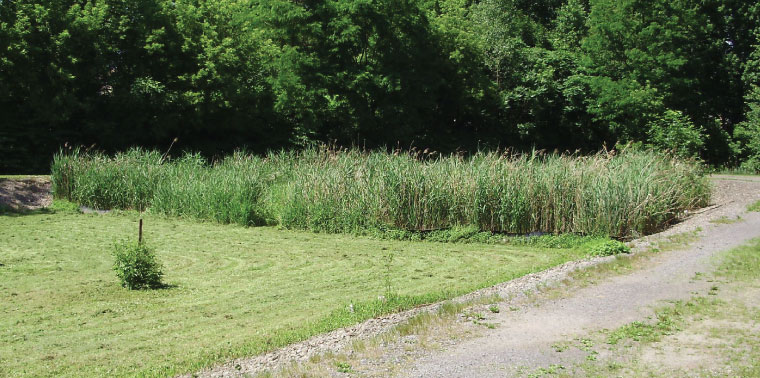February 21, 2013 — Here’s what cutting-edge technology for clean water looks like: a weedy lot measuring 100 by 200 feet. At the wastewater treatment plant in the tiny village of Minoa, N.Y., the scrubby plants and an underlying 18-inch layer of river rock, contained by a plastic liner to make a shallow well, hold the ability to do what few other water treatment systems can: remove pharmaceuticals, environmental pollutants of increasing concern in wastewater streams around the world.
Fill this well with up to 130,000 gallons of drug-laced water and the next day it will come out clean enough to put into a nearby stream. (It is not discharged directly into the stream, however; state regulations require all wastewater to be chlorinated first.) The well — also called a constructed wetland — is the starring attraction at the Minoa facility.
Most wastewater treatment plants do not capture the complex molecules in medicines, such as pain relievers and birth control pills, many of which are harmful to fish, frogs and other wildlife. The U.S. Environmental Protection Agency says the effects of pharmaceuticals and personal care products — more than 100 of which have been identified by EPA scientists in environmental samples and drinking water — on aquatic life are a major concern. The risks to humans are far less clear given the very low concentrations of these contaminants in groundwater and waterways, but the number of compounds and the quantities being discharged continue to rise.
The EPA also recognizes that the nation’s municipal sewage treatment plants are not designed to remove these kinds of pollutants. However, the Minoa facility is doing just that — removing not only the pollutants removed by conventional facilities, but also pharmaceuticals – thanks to a custom mix of bacteria established here by nature and nurtured by a collaboration of town employees and researchers at the State University of New York College of Environmental Science and Forestry in nearby Syracuse. Currently, it’s clearing 60 percent of the ibuprofen and 20 to 30 percent of the estradiol that’s present in the local water.
“We’re cracking pharmaceuticals with something that’s so low tech,” says the plant’s chief operator Steve Giarrusso, a research biologist by training. Giarrusso has worked at the facility for 15 years, using a patchwork of methods to clean the town’s wastewater, including older trickling filters and newer sequencing batch reactors (SBRs).
The 18-year-old constructed wetland may seem simple, but there’s a lot of science and hard-earned experience behind the drug-removal process. Bacteria living in the wetland do the muscle work of breaking down organic compounds, and different species have different specialties, says Chris Nomura, a biochemist at SUNY-ESF. About four years ago, Nomura became interested in testing a wetland’s capacity to remove drug compounds by putting known amounts into the system and then analyzing what was left. Since then he’s identified stock bacterial cultures and developed bacterial husbandry methods, manipulating flow rates, water temperatures and oxygen levels to encourage the best bacterial metabolizers to thrive and do their breakdown thing.
Nomura is not introducing bacteria into the environment; he’s taking advantage of native populations. “The microorganisms adapt to the feed sources,” he says. “The bugs that consume the first effluent — their waste products become feed source for the next population.” Not only that, the process requires no net power.
The Village of Minoa, SUNY-ESF and a private company have joined forces to create an umbrella organization called the Trinity Institute to spread the word about the innovation. The institute offers consulting services to wastewater treatment plants and supports research and education for high school and college students, says director and SUNY-ESF assistant professor Klaus Doelle.
Minoa’s facility is a small plant, treating up to 500,000 gallons of wastewater per day. Half of the wastewater stream goes into sequencing batch reactors, industrial processing tanks that have been adopted widely by wastewater treatment plants in the last 30 years. The other half is processed by the trickling filters; half of that pretreated water is then pumped into the constructed wetland, which can handle about 125,000 gallons per day.
Sequence batch reactors not only fail to remove pharmaceuticals, they also cost a lot more to install (around $2 million) and operate (more than $50,000 per year). A constructed wetland the size of Minoa’s costs maybe $300,000 to install and has almost no operational costs, Doelle says — no chemicals and no electricity. Giarrusso spends about 10 minutes per day monitoring the system to keep it in line with Nomura’s “quick and dirty” encyclopedia of best bacterial conditions.
One downside of the constructed-wetland approach is that it requires some acreage. And the larger the wastewater treatment plant, the larger the wetland would need to be. But the cost savings are compelling when the system is compared to other technologies being developed to remove pharmaceuticals, such as reverse osmosis and ozone treatment.
“It’s a huge cost savings,” Doelle says. “If they have the space, this is viable for small municipalities.”
The Minoa group continues to do research to refine their process, which they’re working to patent, both to remove more pollutants and to increase capacity. Beginning in the spring of 2013 the group will begin working with deeper wells and repeated run-throughs in an attempt to improve the process.
And the idea is starting to catch on. After being ordered to reduce the ammonia level in its landfill leachates, Oswego County, N.Y., entered an agreement with the Village of Minoa. The Minoa team is offering expertise with the bacterial approach as Oswego builds a constructed wetland on top of its landfill.
Like to learn more? Contact Trinity Institute director Klaus Doelle at kdoelle@esf.edu
Ensia shares solutions-focused stories free of charge through our online magazine and partner media. That means audiences around the world have ready access to stories that can — and do — help them shape a better future. If you value our work, please show your support today.
Yes, I'll support Ensia!

Trace amounts of pharmaceutical drugs ending up in the water system post-treatment is a real ecological problem, just recently there was a study done on how high enough levels of fluoxetine (in Prozac) really alters fish behavior, making them shy and in the case of fathead minnows, potentially disrupting reproductive cycles completely. Also to be noted is the factor of biological magnification, as some species are eaten by keystone predators in an ecosystem, the concentrations of the contaminants will magnify as you move up the food web.
Interesting and exciting article though, I enjoyed it. Anytime we can use natural or replicated natural processes/organisms to aid in the logistically daunting problem of dealing with human waste (bodily or otherwise,) it's something to be seriously considered. With the increasing effects of climate change, good water management will only become more and more imperative.
Why are we still not understanding that these helpful micro organisms are not the enemy. Good bacteria are essential to life.